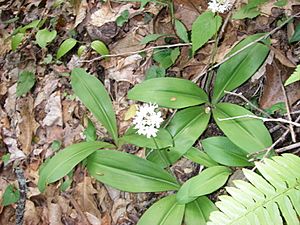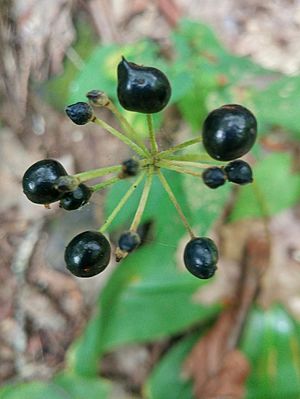White clintonia facts for kids
Quick facts for kids White clintonia |
|
|---|---|
 |
|
| Conservation status | |
| Scientific classification | |
| Genus: |
Clintonia
|
| Species: |
umbellulata
|
| Synonyms | |
|
Synonymy
Clintonia alleghaniensis Harned
Clintonia decantha Raf. Clintonia multiflora Beck Clintonia odorata Raf. Clintonia odorata var. punctata Raf. Clintonia parviflora Raf. Clintonia parviflora var. abortiva Raf. Clintonia parviflora var. plicata Raf. Clintonia podanisia Raf. Clintonia podanisia var. biflora Raf. Clintonia podanisia var. fascicularis Raf. Clintonia podanisia var. glabrata Raf. Clintonia podanisia var. phyllostema Raf. Clintonia podanisia var. phyllostema Raf. Clintonia umbellata Torr. Convallaria umbellulata Michx. Xeniatrum umbellatum (Torr.) Salisb. Xeniatrum umbellulatum (Michx.) Small |
|
The white clintonia (scientific name: Clintonia umbellulata) is a beautiful flowering plant. It's also known as the speckled wood-lily. This plant belongs to the lily family, called Liliaceae. Its scientific name, umbellulata, means "like an umbel." An umbel is a special kind of flower cluster.

Contents
What it Looks Like
The white clintonia is a perennial plant. This means it lives for more than two years. It's a herbaceous plant, which means it has soft stems, not woody ones like trees. It spreads using underground stems called rhizomes.
A white clintonia plant usually grows about 27 to 60 centimeters (11 to 24 inches) tall. It has 2 to 4 dark green leaves. Each leaf is about 18 to 30 cm (7 to 12 in) long and 4.5 to 8 cm (1.8 to 3.1 in) wide.
The flowers grow in a cluster at the top of the plant. This cluster is called an umbel. There are usually 10 to 25 flowers in one cluster. The flowering stalk can be up to 50 cm (20 in) high. Each flower has six petal-like parts called tepals. It also has six stamens, which are the parts that make pollen.
The tepals are white or greenish-white. They often have small purplish-brown or green speckles. Each tepal is about 5.5 to 8 millimeters (0.22 to 0.31 inches) long. The stamens are longer than the tepals. After the flowers, the plant grows black berries. Sometimes, these berries can be a deep blue color. Each berry is about 6 to 8 mm (0.24 to 0.31 in) long. Inside, there are 2 to 4 seeds. Each seed is about 3.5 mm (0.14 in) long.
How to Tell it Apart from Similar Plants
Sometimes, people confuse white clintonia (C. umbellulata) with another plant called C. borealis. They grow in similar areas. Here are some ways to tell them apart:
| What to look for | White Clintonia (C. umbellulata) | Bluebead Lily (C. borealis) |
|---|---|---|
| Where it lives | Hardwood forests below 1,000 meters (3,300 feet) | Mixed forests up to 1,600 meters (5,200 feet) |
| Height | Grows 27 to 60 cm (11 to 24 in) tall | Grows 20 to 50 cm (7.9 to 20 in) tall |
| Leaves | 3 to 4 dark green leaves. Each leaf is 18 to 30 cm (7.1 to 12 in) long. | 2 to 4 shiny dark green leaves. Each leaf is 15 to 30 cm (5.9 to 12 in) long. |
| Flower buds | Buds are round and grow in a tight cluster | Buds are long and grow in a loose cluster |
| Flower cluster | Flowers grow in an umbel (like an umbrella). 10 to 25 flowers face outwards. | Flowers grow in racemes (flowers along a stalk). 3 to 8 flowers hang downwards. |
| Flowers | Tepals are white or greenish white. They often have purple or green speckles. | Tepals are yellow or yellowish green. |
| Fruits | Berries are usually black (sometimes deep blue). They are round or oval. | Berries are deep blue (rarely white). They are egg-shaped. |
It can be hard to identify these plants just by their leaves. But when they are flowering or have berries, it's much easier to tell them apart!
The white clintonia also looks a bit like the small white leek (Allium tricoccum). To tell them apart, look at their leaves. The small white leek's leaves usually wilt and disappear by the time its flowers bloom. But the white clintonia's leaves stay green all summer long.
Plant Names and History
In 1803, a scientist named André Michaux first described this plant. He called it Convallaria umbellulata. Later, in 1894, another scientist named Thomas Morong gave it the name we use today: Clintonia umbellulata.
You might also hear the name Clintonia alleghaniensis. This is another name for a type of white clintonia. It's special because its berries are deep blue, not black. This type grows in places like Virginia, Maryland, and West Virginia.
Where it Grows
The white clintonia is a plant that is endemic to the Appalachian Mountains. This means it naturally grows only in this mountain range. You can find it in the eastern United States, from New York all the way down to Georgia.
It grows in many counties across these states. Some counties where it grows are also home to Clintonia borealis (these are shown in bold in the list below). Even though their ranges seem to overlap, these two plants are actually allopatric. This means their main growing areas don't really mix. Instead, they are right next to each other.
Here are the states and some counties where white clintonia is found:
- New York: Allegany, Cattaraugus, Chautauqua, Erie, Livingston, Wyoming
- Ohio: Ashland, Ashtabula, Columbiana, Coshocton, Harrison, Holmes, Jefferson, Mahoning, Portage, Summit, Trumbull, Tuscarawas, Wayne
- Pennsylvania: Allegheny, Armstrong, Beaver, Bedford, Blair, Butler, Cambria, Centre, Clarion, Clearfield, Crawford, Elk, Erie, Fayette, Forest, Franklin, Fulton, Greene, Huntingdon, Indiana, Jefferson, Lawrence, Mercer, Somerset, Venango, Warren, Washington, Westmoreland
- Maryland: Allegany, Garrett
- West Virginia: Barbour, Braxton, Fayette, Grant, Greenbrier, Hampshire, Hardy, Kanawha, Lincoln, Logan, Marion, McDowell, Mercer, Mineral, Mingo, Monongalia, Monroe, Morgan, Nicholas, Pocahontas, Preston, Randolph, Ritchie, Summers, Tucker, Upshur, Wayne, Webster, Wetzel, Wyoming
- Virginia: Albemarle, Alleghany, Amherst, Augusta, Bath, Bedford, Bland, Botetourt, Buchanan, Carroll, Craig, Dickenson, Floyd, Franklin, Giles, Grayson, Greene, Henry, Highland, Lee, Madison, Montgomery, Nelson, Page, Patrick, Pulaski, Rappahannock, Roanoke, Rockbridge, Rockingham, Russell, Scott, Smyth, Tazewell, Warren, Washington, Wise, Wythe
- Kentucky: Bell, Breathitt, Clay, Harlan, Jackson, Laurel, Lee, Letcher, Menifee, Morgan, Perry, Powell, Rockcastle, Rowan, Wolf
- Tennessee: Blount, Campbell, Carter, Cocke, Cumberland, Greene, Hawkins, Johnson, Monroe, Morgan, Polk, Rhea, Sequatchie, Sevier, Sullivan, Unicoi
- North Carolina: Alleghany, Ashe, Avery, Buncombe, Burke, Caldwell, Clay, Graham, Haywood, Henderson, Jackson, Macon, Madison, McDowell, Mitchell, Polk, Rutherford, Surry, Swain, Transylvania, Watauga, Wilkes, Yancey
- South Carolina: Greenville, Oconee, Pickens
- Georgia: Gilmer, Habersham, Lumpkin, Murray, Rabun, Towns, Union, White
Overall, the white clintonia is considered a secure species globally. However, it is rare or in danger in New York. It is also listed as endangered in Ohio.


